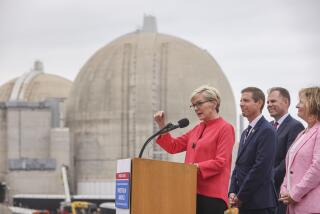17 States Are on Collision Course for Super Collider
- Share via
WASHINGTON — Competition over the siting of the government’s proposed $4.4-billion superconducting super collider began in earnest Wednesday, when elected officials from 17 states urged a House committee to allocate money for the project--preferably in their own state.
California, generally seen with Illinois as leading contenders for what will be one of the largest public works projects in history, livened its sales pitch when Lt. Gov. Leo T. McCarthy disclosed that the state now has under consideration a second potential site for the facility.
A location near Davis, west of Sacramento, is under consideration along with the previously announced site east of Stockton, McCarthy said. The Davis site was added after federal officials released criteria last week that more than doubled the amount of land required for the project to about 16,000 acres. The criteria also eased seismic standards, which earlier had disqualified the Davis site, said William Baker, chairman of the steering committee of the state Super Conductor Siting Commission.
Several other states, meanwhile, made it clear during testimony before the House Committee on Science, Space and Technology that they will try to modify the site-selection process being used by the federal Department of Energy.
Energy Secretary John Herrington called the process “absolutely open and above-board” when he announced it last month, but representatives of rural states contend that certain criteria favor urban, affluent, populous states that can essentially outbid competitors by offering to buy buildings and subsidize electricity to be used by the huge atom smasher.
Can U.S. Afford It?
At the same time, committee members repeatedly, and sometimes heatedly, debated among themselves whether the deficit-ridden federal budget could absorb another multibillion-dollar science project, particularly after recent decisions to build a $14-billion space station, double the budget of the National Science Foundation, proceed with the Strategic Defense Initiative and develop new rockets.
“I don’t need to tell you this country is broke,” Rep. Joel Hefley (R-Colo.) snapped at one point. Advocates, however, said the country must find the money for the collider or risk losing its status as a world leader in science and thus prompting top researchers to go abroad to work.
The early jockeying for advantage gives some indication how seriously many states are approaching their bids for the collider, which consists of an entirely new, college-sized, world-class research facility focused on a giant, circular atom smasher more than 50 miles in circumference.
At least 30 states have expressed an interest in competing for the facility, with several states budgeting millions of dollars to prepare their bids and sell them to Herrington and a blue-ribbon panel from the National Academy of Science and the National Academy of Engineering, who will choose the winner.
An undisclosed number of finalists is set to be chosen in December, with the winner named six months later. Some states, to be safe, plan to submit multiple sites for consideration. California may submit both the Stockton and Davis sites, said Baker.
Money and Jobs
In addition to pumping at least $5.3 billion into the economy of the chosen state, the collider would create 4,500 construction jobs, encourage the creation of new high-tech industries, attract 2,500 well-paid scientists and technicians on a permanent basis, and establish the host state as the world capital of the arcane science of high-energy physics.
The machine, the largest scientific instrument ever conceived, would collide tiny beams of subatomic proton particles at energy levels 20 times currently available. If theorists are correct, the collisions should either allow scientists to discover new, infinitesimally small particles that would confirm existing theories of atomic structure, or they would make surprising new discoveries that would turn science in an entirely new direction.
With ample sums of prestige and money on the line, competition is expected to get even sharper as the Aug. 3 deadline for applications approaches.
More to Read
Sign up for Essential California
The most important California stories and recommendations in your inbox every morning.
You may occasionally receive promotional content from the Los Angeles Times.










